Industrial Bolton (2)
« Previous picture (1) | Next picture (3) »
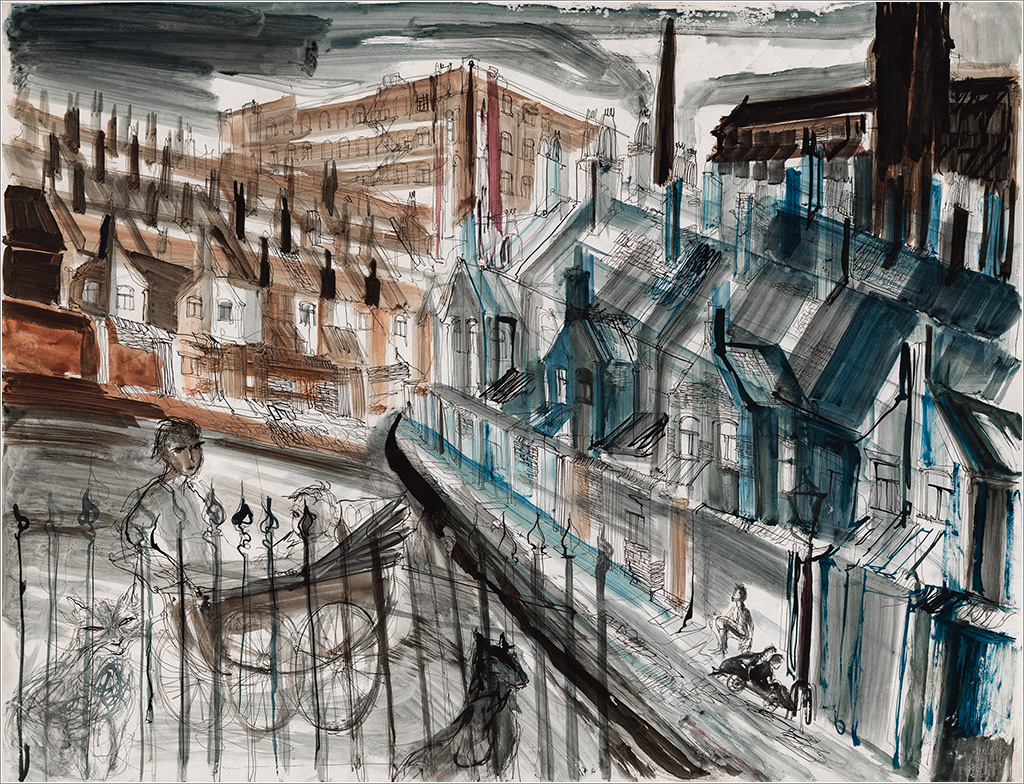
Pen-and-ink and wash painting by Françoise Taylor, 1950s
From pictures of industrial Bolton
« Previous picture (1) | Next picture (3) »
« Previous picture (1) | Next picture (3) »

Pen-and-ink and wash painting by Françoise Taylor, 1950s
From pictures of industrial Bolton
« Previous picture (1) | Next picture (3) »
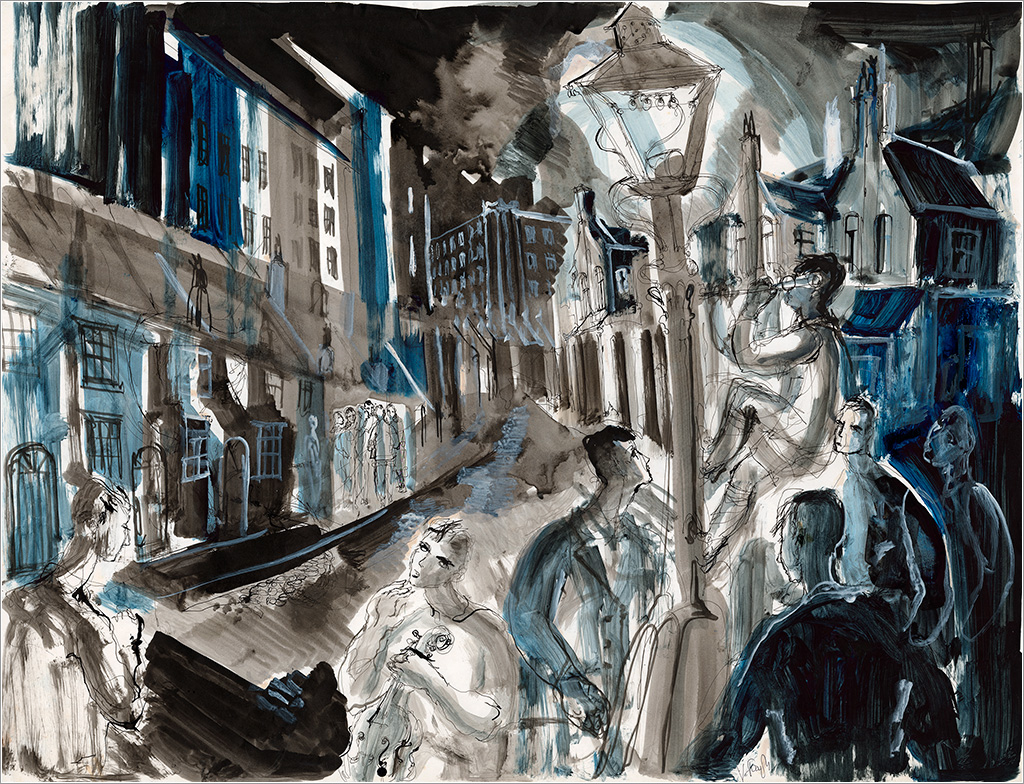
Pen-and-ink and wash painting by Françoise Taylor, 1950s
From pictures of industrial Bolton
1920 (1st January) Françoise Marie Jacqueline Wauters born in Bressoux near Liège, Belgium, the youngest of seven children.
1924 The Wauters family moved from Liège to Brussels.
1925 Françoise started primary school at 5½ – a year early – at a Sacré Coeur girls’ school in Rue de Linhout, Brussels.
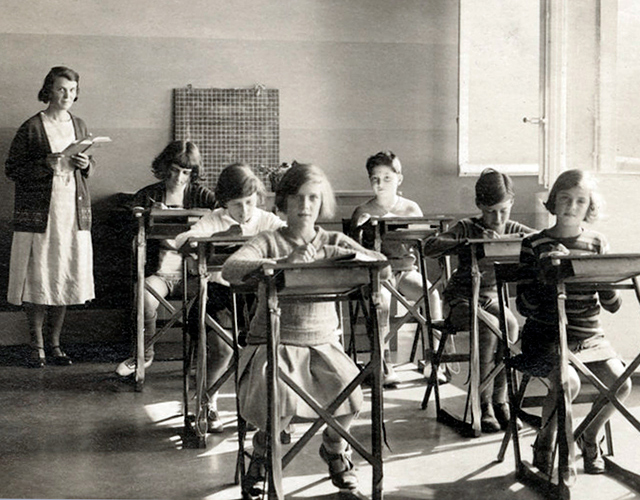
Françoise (centre) at school in Switzerland
1930 (June) Sent for a year to Gai Matin, an open-air school at Chesières in Switzerland, to be cured for decalcification of the teeth.
1931 Returned to the Sacré Coeur school in Brussels. In 1934 for two terms before leaving the school Françoise became a boarder at her own request – for no remembered reason – although it was across the street from the family house in Boulevard Brand Whitlock.
1935 Sent to a Sacré Coeur school at Blumenthal on the Dutch-German border, mainly to learn German. Françoise was in a special class of six foreign pupils and “painted a lot” (her words). Naturally left-handed, she was made to write with her right hand (the custom of the time) but always painted and drew with her left.
1937 Began study at the Académie Royale des Beaux-Arts in Brussels.
1938 Won the first prize for drawing at the Académie Royale.
1939 Won the first prize for drawing at the Académie Royale.
1940 Won the first prize for drawing at the Académie Royale.
The German Occupation of Belgium began on 28th May. Françoise’s brother Jacques Wauters was taken prisoner for nine months by the Germans (reason unknown).
1941 Left the Académie Royale having won only the fourth prize for drawing in that year due to her increasing tendency to elongate and distort the figures in her drawings (a characteristic she retained throughout her artistic life). She had received an excellent grounding in drawing but felt there was “nothing at the Académie Royale to stimulate the imagination”.
Began six-year studies at ‘La Cambre’ – the Ecole Nationale Supérieure d’Architecture et d’Arts Decoratifs in Brussels – specialising in engraving, book illustration and typography. Her tutor was Joris Minne, an important Belgian engraver and book illustrator. Françoise had intended to study sculpture but was persuaded to study book illustration by her father, himself an art lover who admired Turner, the Pre-Raphaelites, Art Nouveau and Ruskin.
1944 Produced her first of many engravings at La Cambre.
“At La Cambre, a beautiful old abbey, most of my friends were progressive ‘intellectuals’ and a lot of them were Communists. I was stimulated to go to concerts, the theatre, and to read enormously. At the start of the second year I felt I was becoming confident in what I was doing, greatly encouraged by my tutor, Joris Minne.”
Also drawing in pen-and-ink with or without painted wash and producing monoprints, lithographs and woodcuts illustrating stories and fables from a wide range of European literature: Emily Brontë (Wuthering Heights), Alain-Fournier (Le Grand Meaulnes), Filip De Pillecyn, Kafka, Conrad, Homer (The Odyssey), Hans Christian Andersen and others. Also scenes from the Bible. Produced a series of drawings Chemin de Croix (Stations of the Cross). At this time Françoise was deeply religious; she remained a devout Catholic for most of her life.
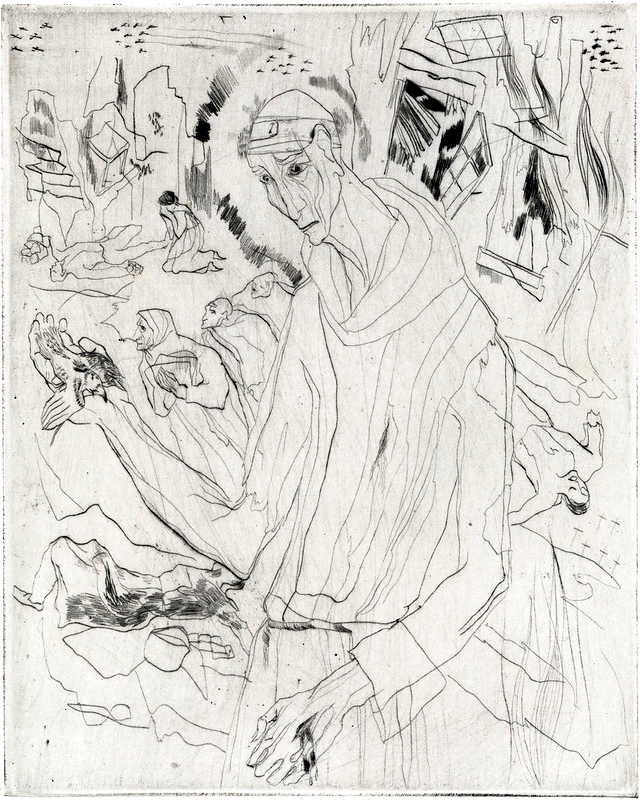
Engraving by Françoise (then Wauters), May 1944
Actual size: 146mm high x 116mm wide
The engraving – only her second – is untitled but marked “Bien sois-tu mon Dieux pour nos [unreadable] les bombes” and is a religious scene depicting the horrors of the allied bombardment of Belgium during the German Occupation of World War II and which Françoise witnessed first-hand. The figure with halo and wounded hand is either Christ down from the cross or one of the saints.
Brussels liberated by Allied forces in early September 1944. Belgium was completely liberated in February 1945.
1945 Became a part-time art teacher at St Joseph’s girls’ school in Antwerp. Also preparing work to submit to a jury to receive a Bourse and enter a Mastery in Book Illustration at La Cambre, for which she was the first in Belgium to be accepted. Produced a series of engravings titled ‘La Guerre’ depicting life in Belgium during the German occupation and recording the terrors of the Deportations and the allied bombardment. Françoise never spoke to any Germans during the war, nor did she ever have any contact with them except through her mother working for the Red Cross.
Met Englishman Kenneth Taylor at the home of Joris Minne in Antwerp. Kenneth had been Signals Officer in the 6th Battalion of Green Howards, part of the Allied Expeditionary Force which landed in Normandy on D-Day and reached Belgium then Nijmegen in Holland by September 1944. In 1945 after seeing action in the Reichwald with the 3rd East Lancs he was assigned to the Belgian Army as a Liaison Officer. Françoise backed out of their first date, sending her mother instead.
1946 During a visit to England (August/September) stayed in High Wycombe at the home of Mrs Eric Gill, wife of the (then deceased) typeface designer and printmaker Eric Gill (reason unknown).
(October) Married Kenneth Taylor in Brussels (to the disgust of her art tutor Joris Minne who for six months refused to look at her drawings). Working on her Mastery in Book Illustration.
(November 1946) Françoise moved with Kenneth to live in Oxford. Continued working on her Mastery in Book Illustration. At this time she did not speak English.
1947 (January) Kenneth began reading PPE at Oxford University.
1948 (February) First son born in Oxford. Moved from Manor Farm, Toot Baldon to Banbury Road, Oxford.
1949 Spent one term at the Ruskin School, Oxford, studying lithography.
(April) Moved from Oxford to Barrow Bridge in Bolton, Lancashire. Kenneth started work in the family business in Horwich near Bolton.
(October) Presented her portfolio in Brussels to a jury of seven of the main art critics in Belgium and was awarded a Diploma with the Highest Distinction and her Mastery in Book Illustration “avec la plus grande distinction et les félicitations du Jury”. The works illustrated were Le Morte d’Arthur (Sir Thomas Malory), The Rime of the Ancient Mariner (Samuel Taylor Coleridge), a Baudelaire poem about cats, The Idiot (Dostoievski), The Basement Room (Graham Greene) and Æsop’s Fables.
1950 Continued to produce engravings which were sent to London for printing. These were now less inspired by literature and more by the environment of industrial Bolton. Despite family commitments (her second son was born this year) Françoise wandered about the streets making sketches of the mills, the gasworks, the back streets, the football matches, the railway stations and the people with their animals, which she then translated onto copper plate and, increasingly, ordinary paper through the medium of pen-and-ink with or without wash. Animals are a feature of her pictures throughout her life.
During the 1950s held a number of exhibitions of her Bolton scenes: Bolton, Salford City Art Gallery, Manchester and other places in the North of England. Work purchased by Manchester Corporation for the permanent collection in the City Art Gallery. A reviewer at the time wrote:
Mrs Taylor sees through the grime of industry and back streets to a kind of beauty – a pathetic, sometimes tragic beauty. There is sorrowful nobility, for example, in the eyes of the dog guarding a squalid door. The children who push perambulators or spot trains, the adults who go about their work, or sit at their doorsteps, or trail wanly by the gasworks, are thin and spectre pale and curiously detached from their surroundings. Only the footballers are well fleshed and fully extrovert. Only these match in human strength and drive the mechanical power and impetus of Mrs Taylor’s locomotives.
Another that:
[the pictures’] beauty is the beauty of design and colour, seldom that of theme, although there is pathos in the wraith-like figures discerned in the encircling industrial gloom, figures presented sometimes with disregard for the perspective, but with powerful symbolism.
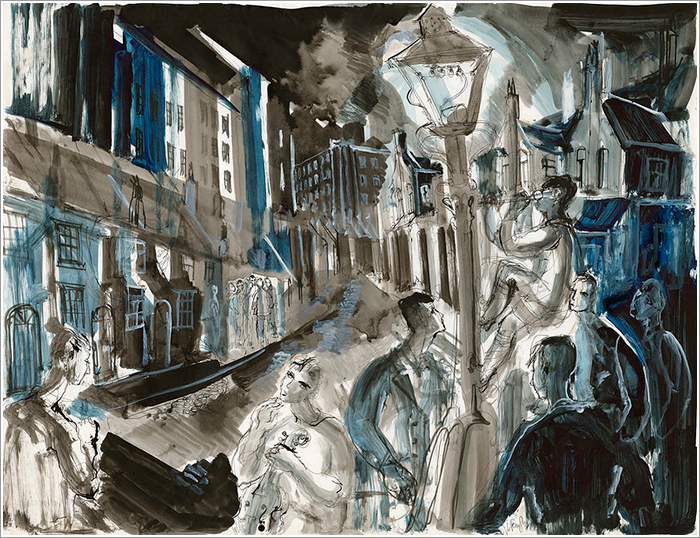
Bolton street scene by Françoise Taylor (1950s)
1951 Third son born in Bolton. Her father Charles Wauters died in Belgium.
1953 Involvement in productions by the Little Theatre, Bolton (eg: drawings for Alice in Wonderland and Through the Looking Glass projected by cyclorama, costumes designs for The Hopeful Travellers).
Moved from Barrow Bridge, Bolton to Heaton, Bolton.
1954 First daughter born in Bolton. Her mother Jeanne Wauters died in Belgium.
1958 Second daughter born in Bolton.
1962 Began painting in oil following a visit to Greece.
1963 Oil paintings exhibited at the Tib Lane Gallery in Manchester but ultimately Françoise did not enjoy the medium and subsequently burned a number of pictures in her back garden (though some have survived, rescued by one of her sons).
Françoise Taylor had no desire to become publicly celebrated as an artist. The exhibitions held during the 1950s and 60s were encouraged by her husband as ‘the thing to do’ and for local people to be able to appreciate the scenes on their walls. Fame and fortune were never a consideration; indeed a number of pictures were done on the reverse side of others or on damaged paper, wet paint carelessly marked with her fingerprints around the edges etc. Françoise had no contact with other artists nor did she take part in the activities of the art establishment, locally or anywhere else. Entirely self-motivated and scathing of artists who sit ‘waiting for inspiration’ she produced some 300 or more ‘Bolton scenes‘ (of which a significant number were purchased privately at her various exhibitions).
1967 Began a teacher training course for Art and French at Chorley College.
1969 Completed her teacher training and was appointed Head of Art at Mount St Joseph girls’ school in Bolton.
1982 Retired from teaching art. Continued to draw and paint on-and-off during the 1980s and up to the mid-1990s. Became interested in pottery and ceramics, working in clay in a local pottery class and using her own kiln at home. Themes included Alice in Wonderland and Venice, increasingly characterising deluded reality and sadness (eg: Alice in the Pool of Tears). Produced both pen-and-ink drawings on white paper and small coloured drawings on coloured paper. Despite having experienced no significant personal tragedies, remaining an active hill walker with Kenneth, maintaining a love of classical music and other interests, in her 70s Françoise entered a period of melancholy and disillusionment with religion which tended to influence her final pictures.
1992 Exhibition of paintings of local street scenes at Mere Hall, Bolton as part of the town’s ‘City Challenge’ initiative for Halliwell (pictures produced in the 1950s and 60s).
1994 Pen-and-ink drawing ‘What a beautiful world‘ in which human children emerge into a harmonious, natural world of animals and plants (one of her last drawings at the age of 74).
2007 Françoise Taylor died from pneumonia at home in Bolton on January 24th aged 87. Kenneth died from similar causes in 2011.
2013 A number of works were taken into the permanent collection at The Whitworth in Manchester. These include a set of her series of 1945 engravings titled La Guerre.
About Françoise Taylor’s drawings
“It is not enough to render by a drawing a definite passage of a literary work. It is necessary that this single drawing renders at the same time all the atmosphere of the subject and all the temperament of the writer. This tour de force, Françoise Wauters succeeds.” Paul-Henri Bourguignon (1906–1988), visual artist and observer of the human condition.
“These are not pictures to hang on the wall and forget in a week or two. Though at first sight they appear decorative, they compel another kind of attention, and the more one looks the more the compulsion grows.” The Guardian, 1950s.
THE ART OF DRAWING is at the heart of almost everything Françoise Taylor produced during over half a century as an artist. It began in 1937, when she was seventeen, with several years of life drawing at the Académie Royale des Beaux-Arts in Brussels (the Belgian version of the British Royal Academy). She almost never drew in pencil. Her primary tools when she moved to ‘La Cambre’ (the Ecole Nationale Supérieure d’Architecture et d’Arts Decoratifs – also in Brussels) became the burin, the etcher’s needle and the woodcutter’s gouge, and sometimes the pen.
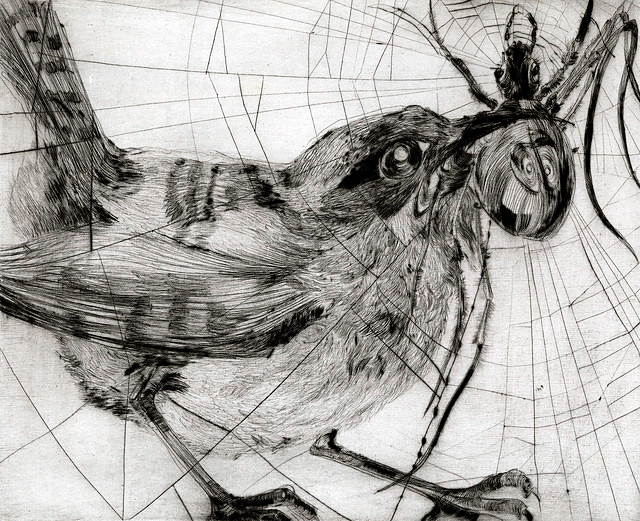
Bird with spider, etching, 1947
Actual size: 197mm high x 241mm wide
She excelled at drawing from the start. At the Académie Royale she won the First Prize for Drawing three years in succession. At La Cambre, where she specialised in engraving and typography, she became the first in Belgium to win a Distinction and a Mastery in Book Illustration awarded by a jury of seven of Belgium’s leading art critics with “the greatest congratulations.”

Drawing by Françoise Taylor, 1945/46
Actual size: 285mm high x 210mm wide
Françoise had by then developed a distinctive style of drawing that was uniquely hers, characterised by line quality and often the distortion of form to create flowing compositions sometimes very simple, sometimes swirling with depth. It was not only line but a combination of line with finely hatched modelling or tone lightly applied with a brush or other implement.
She had a remarkable gift for getting things right with few of the exploratory lines typical of an artist’s drawing. Her representation of hands, for instance, are almost invariably perfect, accurate yet expressive, with no margin for error in her chosen medium. The medium of engraving was not actually her first preference. From an interest in representational form she entered La Cambre after passing a sculpture examination but was advised by her father to study book illustration, presumably as a potentially more lucrative career. Françoise was never much interested in a career. If anything, she intended to become a religeuse.
Ceci est mon corps [ religious ] Calendrier des Pauvres d’Esprit
In 1946, however, Françoise met Englishman Kenneth Taylor in Antwerp at the home of Joris Minne, her tutor at La Cambre. Minne was a Belgian illustrator who helped to revive the art of wood and copper engraving in Belgium. To his disgust Françoise and Kenneth were married in Brussels in 1946 and she emigrated to England. Minne refused to even look at her work for the next six months. Nevertheless she went on to complete her Mastery in Oxford in 1949 by sending to Brussels a large portfolio of engravings, etchings, woodcuts, monoprints and lithographs as illustrations for Le Morte d’Arthur (Sir Thomas Malory), The Rime of the Ancient Mariner (Samuel Taylor Coleridge), a Baudelaire poem about cats, The Idiot (Dostoievski), The Basement Room (Graham Greene) and Æsop’s Fables.
Le Morte d’Arthur [ examples ] The Idiot
Her formative years as an artist in Belgium during the 1940s coincided with the German Occupation and the allied bombardments of 1944 and 1945. More than 1.5 million Belgians had left the country but she and most of her family remained in Brussels – she was a young female artist working in what effectively became a war zone. She witnessed first-hand the Deportations and the deprivations inflicted on the population. These are represented in a series of thirteen drypoints titled ‘La Guerre’ which she completed in August 1945. A complete set is in the permanent collection of the Whitworth Art Gallery in Manchester along with other examples of her work.
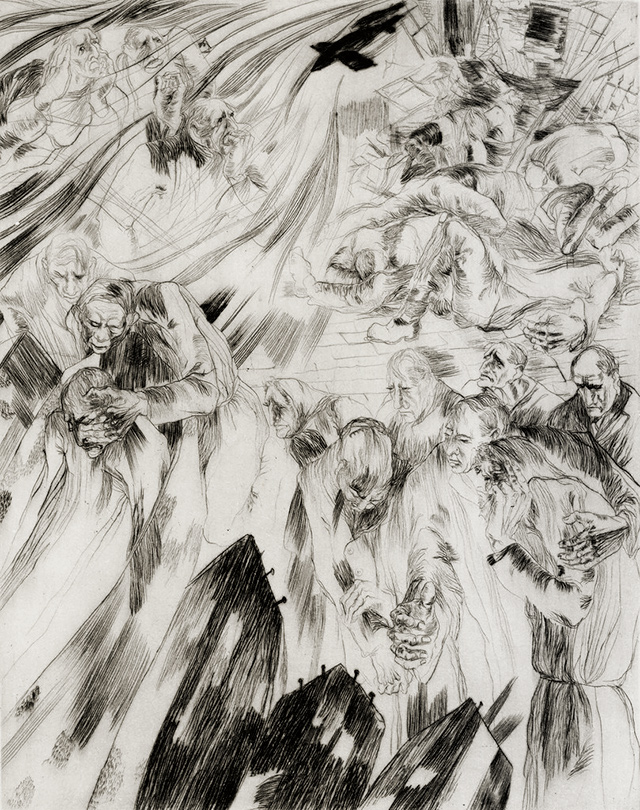
V1 from ‘La Guerre‘, 1944
Actual size: 392mm high x 292mm wide
By the time Françoise Taylor left Belgium at the age of 26 she had already produced hundreds of images – in print or book form – inspired by a wide variety of European literature from Shakespeare to obscure medieval texts, or by her Catholic religion, or by reality, or simply by her remarkable imagination.
Floere het Fluwijn [ examples ] Chemin de Croix
After a couple of years in Oxford she moved to Bolton in North West England – her husband’s home town, an environment she began to illustrate with the fascinated unfamiliarity of an ‘outsider’: a post-war industrial landscape of mills, back streets, gasworks, coal mines, park bandstands and football crowds at Burnden Park, then the home of Bolton Wanderers.
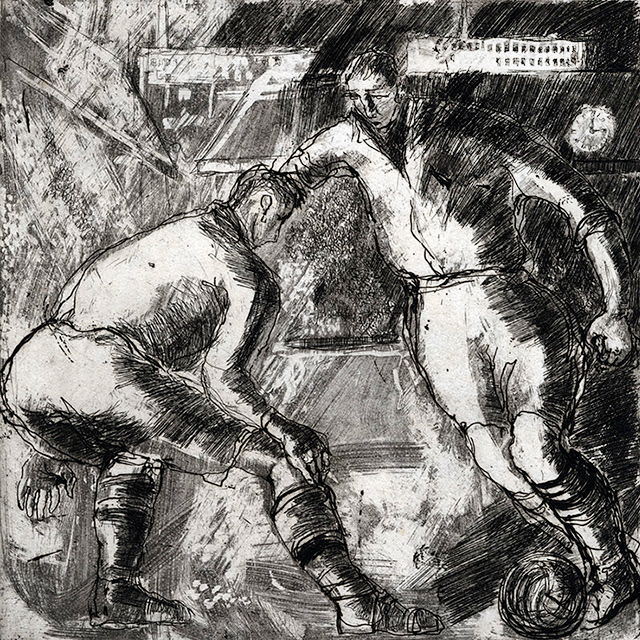
Kick-off at Burnden Park, engraving, mid 1950s
Actual size: 278mm x 278mm
Françoise continued producing engravings until the mid-1950s. The plates were sent to London for printing. Perhaps she found this too time-consuming, or expensive, or being busy raising five children she wanted more immediate results. Either way, her practice of engraving eventually tailed off in favour of larger pen-and-ink drawings combined with watercolour which she created from sketchbooks she recorded while wandering the local streets. She painted a few hundred pictures of industrial Bolton during the 1950s and 60s – many still exist as a pictorial record of a cotton town just as textile manufacturing in England began to enter its dying years. The pictures were exhibited in various towns in the North West and sold well (there are a few examples in the permanent collections of Manchester Art Gallery and Bolton Art Gallery).
Engraving: Bolton Street [ examples ] Painting: industrial Bolton
Inevitably, as she grew older, the firmness of hand Françoise enjoyed in her twenties became less firm and her lines more meandering (if no less expressive). Her eyesight deteriorated to the point where she experienced constant double-vision. Neither of those limitations dampened the will to draw or to continue expressing her favourite literary themes – especially Alice in Wonderland, and now Romeo and Juliet, Venice, Ophelia and the ‘pool of tears’ – sometimes several themes combined into one. She drew in crayon on coloured paper: dreamy pictures she gave away as presents and continued each year with the Christmas cards she’d been drawing ever since coming to England.
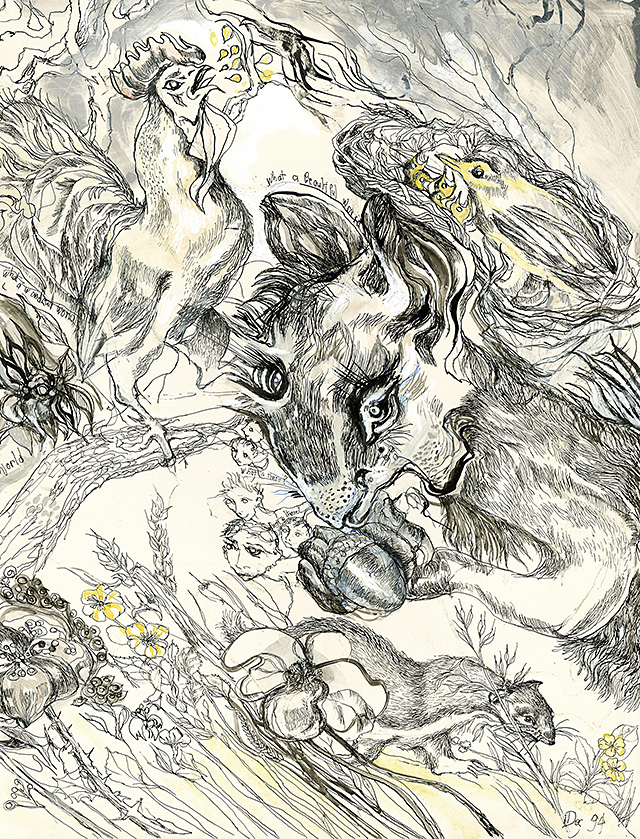
‘What a beautiful world‘ (1994)
Françoise Taylor was still drawing in her late 70s. In ‘What a beautiful world’ human children emerge into a naturally harmonious world of animals and vegetation. She had probably loved the animal world more than the human version with our endless capacity for deliberately heaping hardship and misery upon each other.
A number of Françoise Taylor’s etchings, engravings and drawings are held in the permanent collections of the Cabinet des Estampes of the Bibliothèque Nationale de Paris (National Library of France) and the Bibliothèque Royale de Belgique (Royal Library of Belgium) as well as in the hands of private collectors. They have also been exhibited in Paris, London, and other towns and cities in Belgium and the United Kingdom. Her works in The Whitworth’s permanent collection in Manchester can be viewed by appointment.